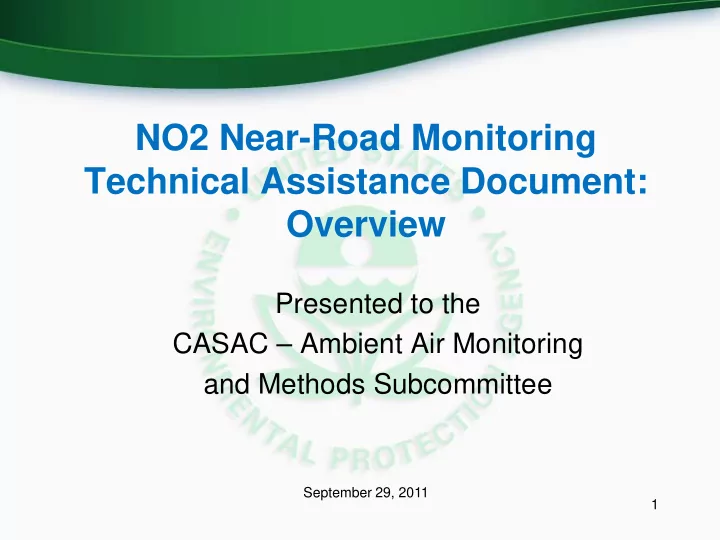

NO2 Near-Road Monitoring Technical Assistance Document: Overview Presented to the CASAC – Ambient Air Monitoring and Methods Subcommittee September 29, 2011 1
Technical Assistance Document (TAD) • Public response to the rule requested further guidance on implementing the near-road NO 2 monitoring network • EPA committed to creating the near-road monitoring TAD – Provides a set of procedures states/locals can use to meet the intentions and requirements of the NO 2 rulemaking – Discusses the merits, methods, and approaches for making near- road NO 2 stations multi-pollutant • CASAC previously provided comments on objectives and outline of TAD in September of 2010 2
TAD Contents • Locating traffic data • Exploratory monitoring • Understanding traffic • Using modeling as a data tool • Traffic data analysis • Site reconnaissance • Ranking candidate road • Site logistics (working segments via traffic data with transportation agencies) • Physical considerations of road segments • Prioritizing candidates • Siting criteria • Multi-pollutant options 9/28/2011 U.S. Environmental Protection Agency 3
Identifying Candidate Sites Flowchart: • Based on traffic indicators • Flexible to allow for differences in data availability 4
Identifying Candidate Sites Step 1. Annual Average Daily Traffic • Rank road segments from highest to lowest total volume in descending order based on total AADT counts – The 2010 Highway Performance Monitoring System (HPMS) provides nationally available data on road segment traffic volumes – State DOTs and city-level MPOs may have more recent AADT counts – Metropolitan area urban travel demand models (TDMs) can also be considered 5
Identifying Candidate Sites Step 2. Fleet Mix • Obtain fleet mix data for each road segment (if available) – Consult State DOTs and city-level MPOs on availability of fleet mix data for given road segments – Minimum differentiation between passenger cars/light trucks and heavy-duty vehicles • Heavy-duty trucks can have emissions of NO x much greater than light-duty passenger cars NOTE: Accounted for in Step 3 6
Identifying Candidate Sites Step 3. Calculate Fleet-Equivalent AADT • If fleet mix data is available, calculate the passenger car equivalent traffic volume for each road segment – Accounts for increased NO 2 emissions of heavy-duty trucks • Re-rank road segments from highest to lowest based on FE-AADT calculation Fleet-Equivalent AADT = ( AADT – HD c ) + ( HD m * HD c ) HD c = total number of heavy-duty vehicles HD m = multiplier to represent increased truck emissions (default = 10) AADT = Annual Average Daily Traffic volume 7
Identifying Candidate Sites Step 3. Calculate Fleet-Equivalent AADT (cont) – HD m value of 10 obtained from MOVES national defaults of fleet mix, speed, and temperatures – TAD provides examples for calculating site-specific HD m values too NOx Emission Month Vehicle Type HDm Ratio Rate (g/mile) Heavy Duty 10.09 January 10.96 Light Duty 0.92 Heavy Duty 8.47 July 9.33 0.91 Light Duty January July 50 45 Motorcycle Motorcycle 45 40 Passenger Car Passenger Car 40 35 NOx Emissions (gpm) Passenger Truck Passenger Truck NOx Emissions (gpm) 35 30 Light Commercial Truck Light Commercial Truck 30 25 Transit Bus 25 Transit Bus 20 School Bus 20 School Bus 15 15 Motor Home Motor Home 10 10 Short-Haul Truck Short-Haul Truck 5 5 8 Long-Haul Truck 0 Long-Haul Truck 0 0 5 10 15 20 25 30 35 40 45 50 55 60 65 70 75 0 5 10 15 20 25 30 35 40 45 50 55 60 65 70 75 Speed (mph) Speed (mph)
Identifying Candidate Sites Step 4. Congestion Patterns • Idling and accelerations associated with congestion can also increase NO 2 emissions – Several metrics can be used to estimate congestion, such as • Level of Service (LOS) • volume-to-capacity ratio • Congestion indicator calculation: Congestion Indicator = AADT/# of lanes • Used for qualitative, comparison purposes only 9
Identifying Candidate Sites TAD provides discussion of other optional methods that may be used to identify candidate sites: • Modeling – EPA’s MOVES and AERMOD models may be used to determine potential locations of maximum NO 2 concentrations along roadways • Monitoring – Saturation monitoring may be used to identify spatial variability of NO 2 concentrations • Stationary samplers (e.g., passive sampling devices) 10 • Mobile monitoring
After ranking candidate sites… • The next step requires state/local agencies to evaluate the feasibility of monitoring at candidate road segments through on-site reconnaissance. • Reconnaissance objectives would relate to: – Roadway design – Roadside features – Terrain – Meteorology – Sampler inlet placement – Logistical feasibility (including permission) – Population considerations 11
Multipollutant Considerations • EPA also encourages states/locals to consider multipollutant monitoring ( this is optional – sans CO ) at near-road NO 2 sites to inform exposure and health studies – The AAMMS previously recommended the following measurements (after NO 2 ) be considered at near-road sites in priority order: • Carbon Monoxide (CO) • Black Carbon (or elemental carbon) • PM number concentration • PM 10 /PM 2.5 mass • EC/OC • Carbon Dioxide (CO 2 ) • Ozone • Speciated VOCs (BTEX, aldehydes) • Speciated PM (organics, metals including Pb) • In August, 2011, EPA finalized requirements for one CO monitor to be co-located with a near-road NO2 site (or placed at an alternative near- road location) in CBSAs having 1 million or more persons (~52 sites).
TAD Development Partners • NO 2 Pilot Study partners: – Broward Co., FL; – City of Albuquerque; – Hillsborough Co., FL; – Idaho Dept. of Env. Quality; – Maryland Dept. of Env. • NACAA member volunteers • State DOTs: Florida DOT & Texas DOT • US DOT – Federal Highways Admin. • EPA Regions • EPA – ORD • EPA – OTAQ • EPA – OAQPS 9/28/2011 U.S. Environmental Protection Agency 13
Recommend
More recommend